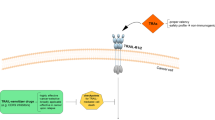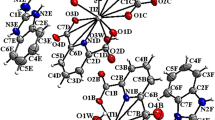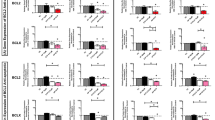Abstract
The ability of death-inducing tumor necrosis factor-related apoptosis-inducing ligand (TRAIL) to selectively kill a variety of cancer cells has been largely described, but one of the major concerns with the treatment is the occurrence of drug resistance and possible toxic side effects. Here, we report that TRAIL induces apoptosis in Jurkat and SUPT1 T cell lines and in human T-ALL blasts but not in healthy subject-derived peripheral blood mononuclear cells. In parallel, the treatment with TRAIL and Tyrphostin (AG-490), a selective Janus kinase 2 inhibitor, produces an evident enhancement of cytotoxicity, characterized by a significant inhibition of Stat3 phosphorylation compared to controls or to TRAIL alone-treated samples, and associated with a dramatic decrease of both cIAP-1 and cIAP-2 mRNA levels. Downregulation of cIAP-1 and cIAP-2 by specific small interference RNAs significantly amplifies TRAIL-reduced cytotoxicity. All together, these findings strongly indicate that cIAP-1 and cIAP-2 downregulation is a fundamental step in the signaling pathways mediating the combinatorial effect of TRAIL and AG-490 on T cell leukemia. These findings may help to open new routes for the development of less toxic pharmacological strategies in the treatment of patients affected by TRAIL-sensitive leukemias.
Similar content being viewed by others
Log in or create a free account to read this content
Gain free access to this article, as well as selected content from this journal and more on nature.com
or
References
Eden T, Pui CH, Schrappe M, Tognoni G, Masera G . All children have a right to full access to treatment for cancer. Lancet 2004; 364:1121–1122.
Kaufman SH, Steensma DP . On the TRAIL of a new therapy for leukemia. Leukemia 2005; 19:2195–2202.
Younes A, Kadin ME . Emerging applications of the tumor necrosis factor family of ligands and receptors in cancer therapy. J Clin Invest 2003; 21:3526–3534.
Kelley SK, Ashkenazi A . Death to the bad guys: targeting death receptors in cancer with Apo2L/TRAIL. Curr Opin Pharmacol 2004; 4:333–339.
Duiker EW, Mom CH, de Jong S, et al. The clinical trail of TRAIL. Eur J Cancer 2006; 42:2233–2240.
MacFarlane M . TRAIL-induced signalling and apoptosis. Toxicol Lett 2003; 139:89–97.
Johnstone RW . Histone-deacetylase inhibitors: novel drugs for the treatment of cancer. Nat Rev Drug Discov 2002; 1:287–299.
Singh TR, Shankar S, Srivastava RK . HDAC inhibitors enhance the apoptosis-inducing potential of TRAIL in breast carcinoma. Oncogene 2005; 24:4609–4623.
Burdelya L, Catlett-Falcone R, Levitzki A, et al. Combination therapy with AG-490 and interleukin 12 achieves greater antitumor effects than either agent alone. Mol Cancer Ther 2002; 1:893–899.
Rahaman SO, Harbor PC, Chernova O, Barnett GH, Vogelbaum MA, Haque SJ . Inhibition of constitutively active Stat3 suppresses proliferation and induces apoptosis in glioblastoma multiforme cells. Oncogene 2002; 21:8404–8413.
Toyonaga T, Nakano K, Nagano M, et al. Blockade of constitutively activated Janus kinase/signal transducer and activator of transcription-3 pathway inhibits growth of human pancreatic cancer. Cancer Lett 2003; 201:107–116.
Wang LH, Kirken RA, Erwin RA, Yu CR, Farrar WL . JAK3, STAT, and MAPK signaling pathways as novel molecular targets for the tyrphostin AG-490 regulation of IL-2-mediated T cell response. J Immunol 1999; 162:3897–3904.
Yu JH, Kim KH, Kim H . Suppression of IL-1β expression by the Jak2 inhibitor AG-490 in cerulean-stimulated pancreatic acinar cells. Biochem Pharmacol 2006; 72:1555–1562.
De Vos J, Jourdan M, Tarte K, Jasmin C, Klein B . JAK2 tyrosine kinase inhibitor tyrphostin AG-490 down regulates the mitogen activated protein kinase (MAPK) and signal transducer and activator of transcription (STAT) pathways and induces apoptosis in myeloma cells. Br J Haematol 2000; 109:823–828.
Takemoto S, Mulloy JC, Cereseto A, et al. Proliferation of adult T cell leukemia/lymphoma cells is associated with the constitutive activation of JAK/STAT proteins. Proc Natl Acad Sci USA 1997; 94:13897–13902.
Stepkowski SM and Kirken RA . Unique advantages of Janus Kinase 3 as a target for selective and nontoxic immunosuppression. Expert Rev Clin Immunol 2005; 1:307–310.
Meydan N, Grunberger T, Dadi H, et al. Inhibition of acute lymphoblastic leukaemia by a Jak-2 inhibitor. Nature 1996; 379:645–648.
Kirken RA, Erwin RA, Taub D, et al. Tyrphostin AG-490 inhibits cytokine-mediated JAK3/STAT5a/b signal transduction and cellular proliferation of antigen-activated human T cells. J Leukoc Biol 1999; 65:891–899.
Yeh TC, Pellegrini S . The Janus Kinase family of protein tyrosine kinase and their role in signalling. Cell Mol Life Sci 1999; 19:1523–1534.
Mazurkiewicz-Munoz AM, Argetsinger LS, Kouadio JL, et al. Phosphorylation of JAK2 at serine 523: a negative regulator of JAK2 that is stimulated by growth hormone and epidermal growth factor. Mol Cell Biol 2006; 26:4052–4062.
Stephanou A, Brar BK, Knight RA, Latchman DS . Opposing actions of STAT-1 and STAT-3 on the Bcl-2 and Bcl-x promoters. Cell Death Differ 2000; 7:329–330.
Alas S, Bonavida B . Rituximab inactivates signal transducer and activation of transcription 3 (STAT3) activity in B-non-Hodgkin's lymphoma through inhibition of the interleukin 10 autocrine/paracrine loop and results in down-regulation of Bcl-2 and sensitization to cytotoxic drugs. Cancer Res 2001; 61:5137–5144.
Alas S, Bonavida B . Inhibition of constitutive STAT3 activity sensitizes resistant non-Hodgkin's lymphoma and multiple myeloma to chemotherapeutic drug-mediated apoptosis. Clin Cancer Res 2003; 9:316–326.
Hasegawa T, Suzuki K, Sakamoto C, et al. Expression of the inhibitor of aoptosis (IAP) family members in human neutrophils: up-regulation of cIAP-2 by granulocyte colony-stimulating factor and overexpression of cIAP-2 in chronic neutrophilic leukaemia. Blood 2003; 101:1164–1171.
Bremer E, van Dam G, Kroesen BJ, de Leij L, Helfrich W . Target induction of apoptosis for cancer therapy: current progress and prospects. Trends Mol Med 2006; 12:382–393.
Schimmer AD, Welsh K, Pinilla C, et al. Small-molecule antagonists of apoptosis suppressor XIAP exhibit broad antitumor activity. Cancer Cell 2004; 5: 25–35.
Deveraux QL, Reed JC . IAP family proteins-suppressors of apoptosis. Gen Dev 1999; 13:239–252.
Chu ZL, McKinsey TA, Liu L, Gentry JJ, Malim MH, Ballard DW . Suppression of tumor necrosis factor-induced cell death by inhibitor of apoptosis c-IAP2 is under NF-κB control. Proc Natl Acad Sci USA 1997; 94:10057–10062.
Song H, Wang R, Wang S, Lin J . A low-molecular-weight compound discovered through virtual database screening inhibits Stat3 function in breast cancer cells. Proc Natl Acad Sci USA 2005; 102:4700–4705.
Bhasin D, Cisek K, Pandharkar T, et al. Design, synthesis, and studies of small molecule STAT3 inhibitors. Bioorg Med Chem Lett 2008; 18:391–395.
Chen CL, Loy A, Cen L, et al. Signal transducer and activator of transcription 3 is involved in cell growth and survival of human rhabdomyosarcoma and osteosarcoma cells. BMC Cancer 2007; 7:78–90.
Mori E, Thomas M, Motoki K, Kataika S . Distinct function of monoclonal antibody to TRAIL-R2 as potentiator or inhibitor of the ligand TRAIL-induced apoptosis. FEBS Lett 2005; 579:5379–5384.
Mori E, Thomas M, Motoki K, et al. Human normal hepatocytes are susceptible to apoptosis signal mediated by both TRAIL-R1 and TRAIL-R2. Cell Death Differ 2004; 11:203–207.
Mazurek N, Sun YJ, Liu KF, et al. Phosphorylated galectin-3 mediates tumor necrosis factor-related apoptosis-inducing ligand (TRAIL) signaling by regulating PTEN in human breast carcinoma cells. J Biol Chem 2007; 282:21337–21348.
Pui CH, Evans WE . Acute lymphoblastic leukemia. N Engl J Med 1998; 339:605–615.
Litzow MR . Acute lymphoblastic leukemia in adults. Curr Treat Options Oncol 2000; 1:19–29.
Wang P, Song JH, Song DK, Zhang J, Hao C . Role of death receptor and mitochondrial pathways in conventional chemotherapy drug induction of apoptosis. Cell Signal 2006; 18:1528–1535.
Mori T, Doi R, Toyoda E, et al. Regulation of the resistance to TRAIL-induced apoptosis as a new strategy for pancreatic cancer. Surgery 2005; 138:71–77.
Meurette O, Fontaine A, Rebillard A, et al. Cytotoxicity of TRAIL/anticancer drug combinations in human normal cells. Ann N Y Acad Sci 2006; 1090:209–216.
Ganten TM, Koschny R, Haas TL, et al. Proteasome inhibition sensitizes hepatocellular carcinoma cells, but not human hepatocytes, to TRAIL. Hepatology 2005; 42:588–597.
Di Pietro R, Secchiero P, Rana R, et al. Ionizing radiation sensitizes erythroleukemic cells but not normal erythroblasts to tumor necrosis factor-related apoptosis-inducing ligand (TRAIL)-mediated cytotoxicity by selective up-regulation of TRAIL-R1. Blood 2001; 97:2596–2603.
de Graaf AO, van Krieken JH, Tonnissen E, et al. Expression of C-IAP1, C-IAP2 and SURVIVIN discriminates different types of lymphoid malignancies. Br J Haematol 2005; 130:852–859.
Lin TS, Mahajan S, Frank DA . STAT signaling in the pathogenesis and treatment of leukemias. Oncogene 2000; 19:2496–2504.
Rajasingh J, Raikwar HP, Muthian G, Johnson C, Bright JJ . Curcumin induces growth-arrest and apoptosis in association with the inhibition of costitutively active JAK-STAT pathway in T cell leukemia. Bioc Biophis Res Comm 2006; 340:359–368.
Tomita M, Kawakami H, Uchihara JN, et al. Inhibition of constitutively active Jak-Stat pathway suppresses cell growth of human T-cell leukemia virus type 1-infected T-cell lines and primary adult T-cell leukemia cells. Retrovirology 2006; 3:22–32.
Moriai R, Asanuma K, Kobayashi D, et al. Quantitative analysis of the anti-apoptotic gene surviving expression in malignant haematopoietic cells. Anticancer Res 2001; 21:595–600.
Nakagawa Y, Yamaguchi S, Hasegawa M, et al. Differential expression of survivin in bone marrow cells from patients with acute lymphocytic leukaemia and chronic lymphocytic leukemia. Leukemia Res 2004; 28:487–494.
Kamihira S, Yamada Y, Hirakata Y, et al. Aberrant expression of caspase cascade regulatory genes in adult T-cell leukaemia: survivin is an important determinant for prognosis. Br J Haematol 2001; 114:63–69.
Mirandola P, Sponzilli I, Gobbi G, et al. Anticancer agents sensitize osteosarcoma cells to TNF-related apoptosis-inducing ligand downmodulating IAP family proteins. Int J Oncol 2006; 28:127–133.
Uno K, Inukai T, Kayagaki N, et al. TNF-related apoptosis-inducing ligand (TRAIL) frequently induces apoptosis-inducing ligand (TRAIL) frequently induces apoptosis in Philadelphia chromosome positive leukaemia cells. Blood 2003; 101:3658–3667.
Pitti RM, Marsters SA, Ruppert S, Donahue CJ, Moore A, Ashkenazi A . Induction of apoptosis by Apo-2 ligand, a new member of the tumor necrosis factor cytokine family. J Biol Chem 1996; 271:12687–12690.
Chen HX, Liu YJ, Zhou XD, Lou RY . Expression of cellular FLICE/caspase-8 inhibitory protein is associated with malignant potential in endometrial carcinoma. Int J Gynecol Cancer 2005; 15:663–670.
Bertagnolo V, Brugnoli F, Marchisio M, Celeghini C, Carini C, Capitani S . Association of PI 3-K with tyrosine phosphorylated Vav is essential for its activity in neutrophil-like maturation of myeloid cells. Cell Signal 2004; 16:423–433.
Acknowledgements
This work was supported by Italian MIUR-COFIN 2007 funds, by Fondazione Carichieti, Chieti, Italy and by a generous donation of Marco Romanelli and Donatella De Sanctis on the day of their wedding. The authors wish to thank Prof John C Byrd (The Ohio State University, USA) for his critical review of the manuscript.
Author information
Authors and Affiliations
Corresponding author
Supplementary information
Supplementary information, Figure S1
Flow cytometry analysis of surface expression of TRAIL receptors in Jurkat cells. (PDF 125 kb)
Supplementary information, Figure S2
Flow cytometry analysis of apoptosis in Jurkat cells after the treatment with STA-21, TRAIL or with the agonists combined together. (PDF 98 kb)
Supplementary information, Figure S3
cFLIPs/l mRNA transcription and protein level. (PDF 89 kb)
Supplementary information, Figure S4
Representation of the hypothetic mechanism of AG-490-mediated increase of T tumour cell sensitivity to TRAIL. (PDF 114 kb)
Rights and permissions
About this article
Cite this article
Lanuti, P., Bertagnolo, V., Pierdomenico, L. et al. Enhancement of TRAIL cytotoxicity by AG-490 in human ALL cells is characterized by downregulation of cIAP-1 and cIAP-2 through inhibition of Jak2/Stat3. Cell Res 19, 1079–1089 (2009). https://doi.org/10.1038/cr.2009.80
Received:
Revised:
Accepted:
Published:
Issue date:
DOI: https://doi.org/10.1038/cr.2009.80
Keywords
This article is cited by
-
NOR-1/NR4A3 regulates the cellular inhibitor of apoptosis 2 (cIAP2) in vascular cells: role in the survival response to hypoxic stress
Scientific Reports (2016)
-
Resveratrol and STAT inhibitor enhance autophagy in ovarian cancer cells
Cell Death Discovery (2016)
-
MiR-145 promotes TNF-α-induced apoptosis by facilitating the formation of RIP1-FADDcaspase-8 complex in triple-negative breast cancer
Tumor Biology (2016)
-
GDC-0152 induces apoptosis through down-regulation of IAPs in human leukemia cells and inhibition of PI3K/Akt signaling pathway
Tumor Biology (2015)
-
Water-soluble platinum phthalocyanines as potential antitumor agents
BioMetals (2014)



